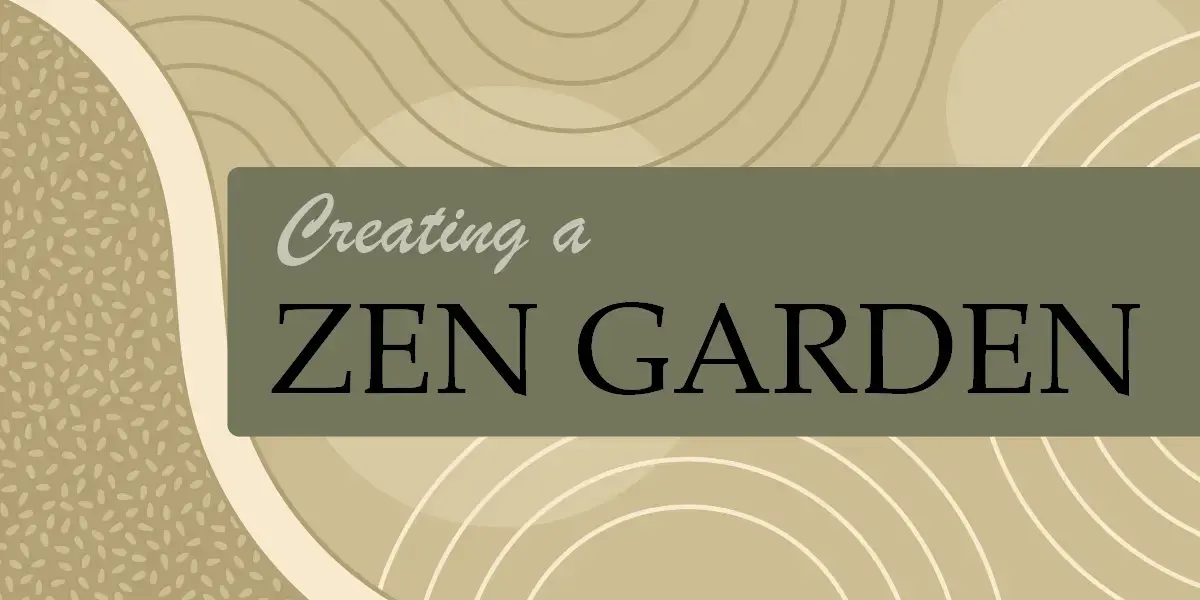Does life have you tied in knots? Try Zen.
No, you don’t have to withdraw to a mountaintop retreat when you can build a Zen garden instead.
A Zen garden won’t solve your troubles but can help you find peace in a hectic and demanding world. Cue the bamboo flute music; let’s get started.
The Essence of a Zen Garden
Zen Buddhism promotes the idea that enlightenment is accessible here and now, not in some distant time or place. It invites you to cultivate inner peace and wisdom by finding harmony within yourself and your surroundings. Tranquil surroundings lead to a more tranquil you.
The simplicity and natural beauty of the garden encourage mindfulness and contemplation.

Patterns in the sand made by a rake with widely spaced teeth.
What You’ll Need
Every element you choose should contribute to the garden’s harmony.
- Rocks and stones represent islands or mountains and form the garden’s centerpiece. Choose stones of varying sizes and shapes for visual interest.
- Gravel or sand symbolizes water, mimicking ripples or waves when raked and adding a dynamic element to the garden.
- Typically, Zen gardens feature no or only a select few plants, such as moss, bamboo, or small shrubs. Choose plants that are easy to maintain and fit the garden’s aesthetic.
- Borders and edging: Use wooden planks, metal edging, or stones to define the boundaries of your Zen garden, ensuring a neat and structured appearance.
- Landscape fabric can create a base layer to prevent weeds from growing and keeping the gravel or sand in place.
- Tools: You need only a rake, trowel, and small pruning shears to keep your Zen garden looking its best.
Planning Your Zen Garden
Step 1: Pick the Location
- Select a quiet and flat area, indoors or outdoors, to create a serene space.
- Ensure the site gets an appropriate balance of light and shade to suit the simplicity of the Zen garden.
Step 2: Decide on the Layout
- Sketch a layout for your garden, including the placement of gravel, rocks, and plants.
- Aim for asymmetry, which is common in Zen garden design, as it reflects the natural imperfections of the world.
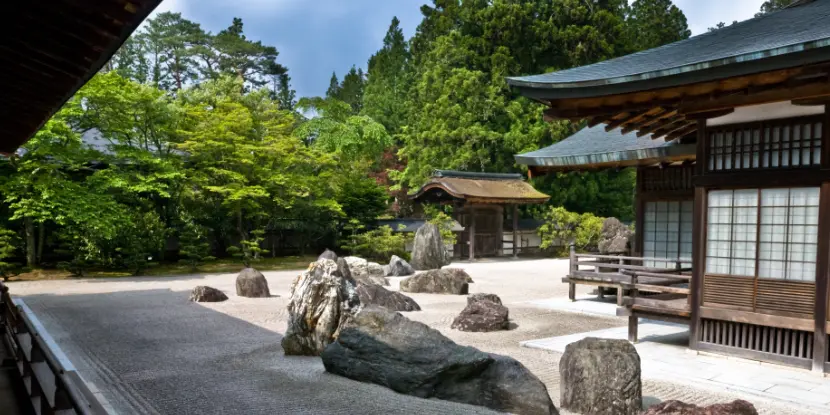
Traditional Zen garden with boulders and gravel only.
Step 3: Gather Materials
- Purchase fine gravel or sand for the base, as it forms the garden’s foundation.
- Select various rocks in different sizes and shapes to serve as focal points.
- Include plants like bamboo or moss, but use greenery sparingly to preserve a minimalist aesthetic.
Step 4: Prepare the Ground
- Clear the area of grass, weeds, and debris to create a clean slate.
- Level the ground and add landscape fabric to prevent weeds from growing.
Step 5: Install a Border
- Use wooden planks, stone, or metal edging to frame your Zen garden and contain the gravel.
- A defined border enhances the visual structure of the garden.

An indoor Zen garden with plants incorporated into the design.
Step 6: Arrange the Rocks
- Place rocks strategically to create a natural yet balanced look.
- Consider the symbolism of the rocks; they can represent mountains, islands, or other natural features.
Step 7: Spread the Gravel
- Cover the entire garden area with a layer of fine gravel or sand about two inches deep.
- Smooth it evenly with a rake.
Step 8: Add Minimal Plants
- To enrich the composition, include a few well-chosen plants, such as bamboo, small shrubs, or tufts of moss.
- Avoid over-planting to preserve the garden’s serene and uncluttered look.
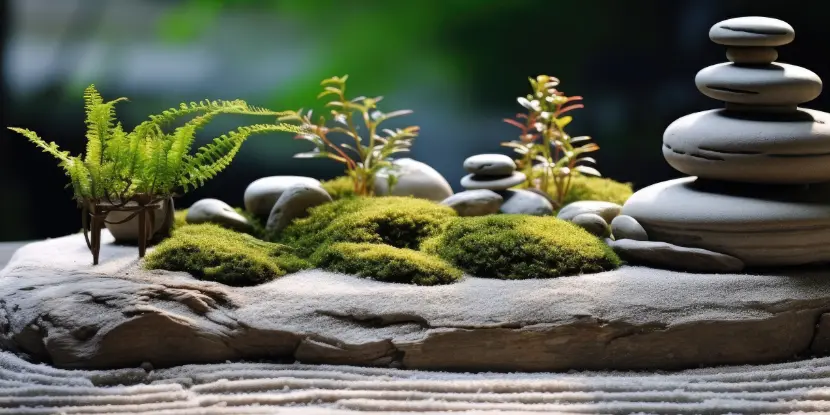
A rock “oasis” in a Zen garden.
Step 9: Final Touches
- Use a rake to create patterns in the gravel, such as rippling waves or straight lines. These represent water and enhance the garden’s meditative quality.
- Step back and adjust as needed until the design hits you just right.
Maintaining Your Zen Garden
A Zen garden requires minimal maintenance. However, regular upkeep ensures it remains a peaceful retreat.
- Rake the Sand or Gravel: Groom the sand or gravel regularly to retain clean lines and patterns and keep the garden looking neat.
- Weed Control: Check for weeds periodically and remove them promptly. Applying a layer of landscape fabric beneath the gravel can inhibit weed growth.
- Prune Plants: Keep plants trimmed and tidy, preventing them from overwhelming the garden’s simplicity.
- Refresh Gravel or Sand: Sand or gravel may become compacted or discolored over time. Adding a fresh layer can revitalize the garden’s appearance.
Incorporating Personal Touches
While traditional Zen gardens adhere to strict design principles, there’s room for personalization. Other elements might include:
- A fountain or pond
- Sculptures and lanterns
- Bonsai trees
- Pathways or stepping stones
Remember, the goal is to create a space that invites contemplation and inner peace.
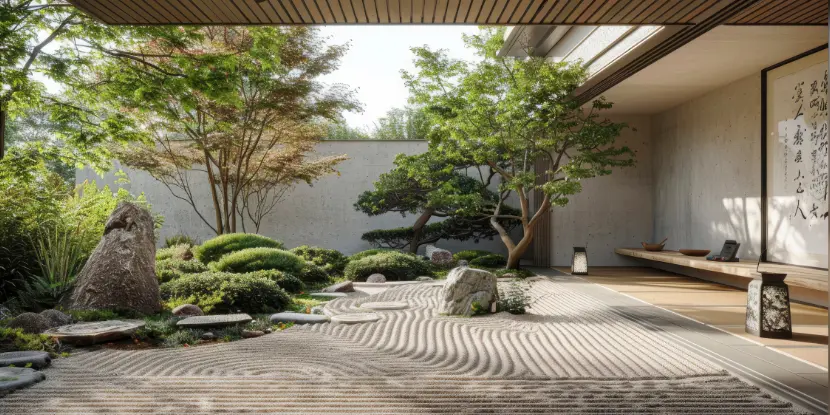
A small Zen garden in a backyard area.
Overcoming Common Challenges
- Consider a tabletop Zen garden or a smaller corner garden if space is limited. These compact versions offer the same tranquility in a smaller footprint.
- If you’re concerned about upkeep, choose low-maintenance plants and materials. Opt for hardy stones and weather-resistant borders to ensure your garden withstands the elements.
- To lower costs, source materials locally or repurpose items you already have. For example, use rocks from your backyard or repurpose old wooden planks as borders.
Finding Inspiration for Your Zen Garden
Look to traditional Japanese gardens for classic design elements and techniques. Visit local botanical gardens or seek inspiration online from garden design websites and forums.
Nature itself is a rich source of inspiration. Observe the natural landscapes around you and incorporate elements that resonate with you into your garden design.
Don’t hesitate to draw inspiration from art and literature. Zen philosophy and aesthetics have influenced countless artists and writers, providing a rich source of inspiration for your Zen garden.
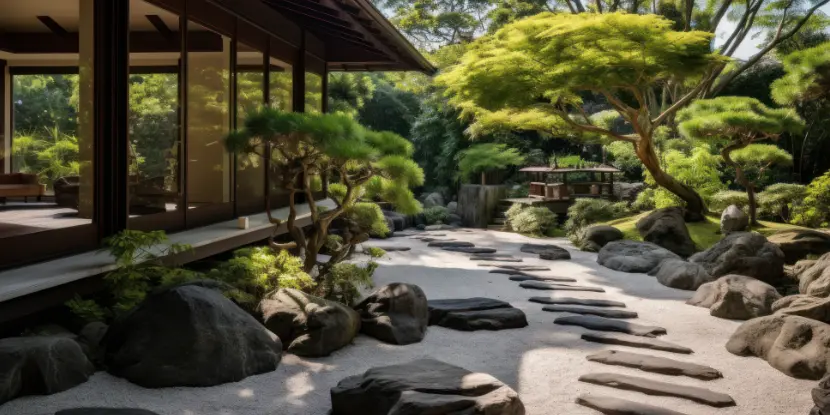
A gravel Zen garden with paving stones.
Additional Tips
- Consider incorporating natural elements like rocks or plants native to your area for an authentic touch.
- Experiment with different rake patterns or patterns inspired by nature, like concentric circles or spirals.
- Feel free to make minor changes as your garden evolves and adapts. Zen gardens reflect the present moment and can change with you.
FAQs About Zen Gardens
Q: Can I create a Zen garden without sand or gravel?
To create a similar effect, you can use alternatives like crushed granite, pebbles, or even small river rocks.
Q: How often should I rake my Zen garden?
As often as needed to maintain the desired look and feel. Some people rake daily as part of their meditation practice, while others may only do it weekly.
Q: Can I add color to my Zen garden?
While most traditional Zen gardens are monochromatic, some variations incorporate subtle pops of color through plants or decorative elements.
Q: What size should a Zen garden be?
A Zen garden can be any size that suits your space and needs. Large outdoor Zen gardens are common, but smaller versions, such as tabletop or balcony gardens, can provide the same tranquility.
Q: Can I use artificial plants in a Zen garden?
Artificial plants can be an option if maintenance is a concern. They should look realistic and blend seamlessly with the rest of the design.
Q: Do Zen gardens need a lot of sunlight?
Zen gardens don’t have strict sunlight requirements. However, if you incorporate living plants, consider their light needs and place them in the garden accordingly.
Q: How can I make my Zen garden weather-resistant?
Use durable materials like stone or treated wood for the border, and high-quality gravel or sand that can withstand the elements. Placing the garden in a sheltered area can also help protect it from harsh weather.
Q: Is a Zen garden suitable for public spaces?
Zen gardens can be an excellent addition to public spaces like parks, courtyards, and corporate environments. They provide a peaceful area for relaxation and can help create a serene atmosphere in a busy setting.
Q: What’s the difference between a rock garden and a Zen garden?
A rock garden usually features a combination of rocks and plants, while Zen gardens are primarily composed of sand or gravel with minimal plant elements. Also, Zen gardens incorporate specific design principles to create a sense of peace and harmony.

